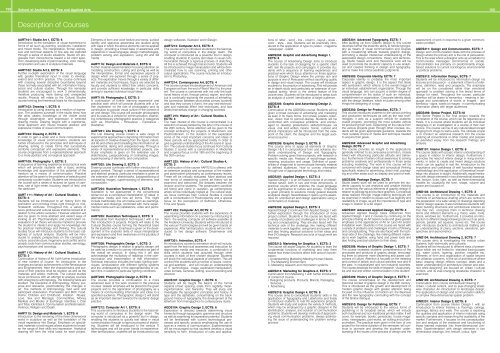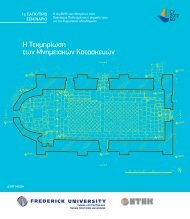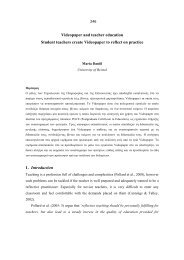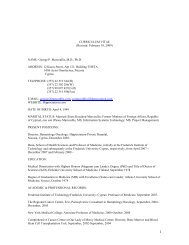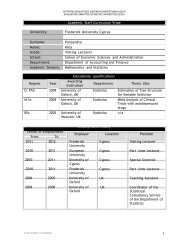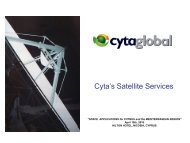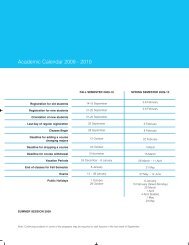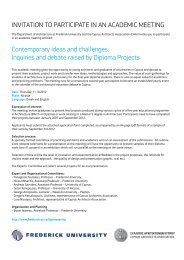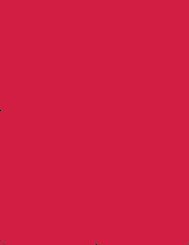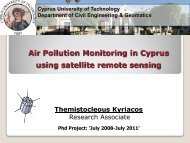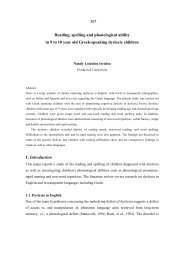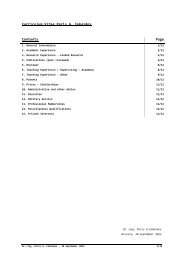Department of Architecture - Frederick University
Department of Architecture - Frederick University
Department of Architecture - Frederick University
You also want an ePaper? Increase the reach of your titles
YUMPU automatically turns print PDFs into web optimized ePapers that Google loves.
152<br />
School <strong>of</strong> <strong>Architecture</strong>, Fine and Applied Arts 153<br />
Description <strong>of</strong> Courses<br />
AART101: Studio Art 1, ECTS: 6<br />
Introduction to the translation <strong>of</strong> visual experience to<br />
forms <strong>of</strong> art such as painting, sculptures, installation<br />
and mixed media. The interpretative, formal, expressive<br />
and technical aspects <strong>of</strong> fine arts are explored<br />
through a series <strong>of</strong> studio situations. Studio Art progresses<br />
from monochrome toward a full color spectrum,<br />
developing skills <strong>of</strong> paint handling, color mixing,<br />
composition and use <strong>of</strong> sculpture materials.<br />
AART102: Studio Art 2, ECTS: 6<br />
Further in-depth exploration <strong>of</strong> the visual language<br />
with greater theoretical input in order to develop,<br />
extend and confirm practice. This course continues<br />
with crossing several discipline boundaries beyond<br />
those normally associated with art; information theory,<br />
social and cultural studies. Through the semester<br />
students are encouraged to work 3 dimensionally,<br />
therefore producing more daring and unexpected<br />
results. Projects will relate to the Cultural Studies<br />
course forming the theoretical basis for this discipline.<br />
AART103: Drawing 1, ECTS: 6<br />
Introduction to using drawing as a medium <strong>of</strong> expression.<br />
The problems surveyed in the studio show how<br />
the artist attains knowledge <strong>of</strong> the visible world<br />
through observation, and expression in selected<br />
drawing media. Drawing begins with a representational<br />
approach and moves towards abstract and<br />
expressive modes <strong>of</strong> visual communication.<br />
AART104: Drawing 2, ECTS: 6<br />
In order to gain a wider and a more comprehensive<br />
knowledge <strong>of</strong> visual communication, students are<br />
further introduced to the principles and techniques <strong>of</strong><br />
drawing, aiming to create forms that successfully<br />
combine conceptual and expressive elements. The<br />
course progresses from a representational approach<br />
to a more abstract and conceptual approach.<br />
AART109: Photography 1, ECTS: 3<br />
A sequence <strong>of</strong> learning experience and practical work<br />
which will provide students with a basic working<br />
knowledge and appreciation <strong>of</strong> the potential <strong>of</strong> the<br />
medium as a means <strong>of</strong> communication. Practical<br />
attention will be given to the problems <strong>of</strong> selecting and<br />
composing course matter. Students are introduced to<br />
the course with a series <strong>of</strong> lectures on types <strong>of</strong> cameras,<br />
use <strong>of</strong> light meter, focusing, depth <strong>of</strong> field, and<br />
the darkroom.<br />
AART 111: History <strong>of</strong> Art / Cultural Studies 1,<br />
ECTS: 3<br />
Students will be introduced to art history from the<br />
prehistoric and primitive times right through to midnineteenth<br />
centuries. Throughout this, a variety <strong>of</strong><br />
socio-political and cultural issues shall be looked at in<br />
relation to the artistic evolution. However attention will<br />
also be given to more abstract and variant ways <strong>of</strong><br />
looking at art. Psychoanalysis and postmodern reevaluation<br />
<strong>of</strong> art theory will also be implied to provoke<br />
the student to interact and apply his knowledge into<br />
his practical methodology and thinking. The cultural<br />
studies focus will introduce students to the basic categories<br />
<strong>of</strong> cultural analysis. Students will be introduced<br />
to analytic perspectives on the concepts <strong>of</strong><br />
culture, social structure, hegemony and conflict and to<br />
analytic tools from communication studies, semiology,<br />
psychoanalysis and sociology.<br />
AART 112: History <strong>of</strong> Art / Cultural Studies 2,<br />
ECTS: 3<br />
Continuation <strong>of</strong> History <strong>of</strong> Art I with further introduction<br />
<strong>of</strong> new content <strong>of</strong> course. An introduction to the<br />
changes and artistic achievements <strong>of</strong> the Renaissance<br />
and Enlightenment. Here the characteristics and purpose<br />
<strong>of</strong> their practice shall be studied, as well as the<br />
materials and artistic methods. The cultural studies<br />
focus continuous with an attempt to analyze courses<br />
with reference to anthropology. The following fields are<br />
studied: The Discipline <strong>of</strong> Anthropology, history, purpose<br />
and relevance, postmodernity, the changes in<br />
art; The methods <strong>of</strong> Anthropology; field work and<br />
participant observation; Procreation and Birth; Food;<br />
Home; Children and Childhood; Initiation Rituals;<br />
Love, Sex and Marriage; Commodities, Money<br />
Markets and Modes <strong>of</strong> Exchange; Identities I, Clan<br />
and Tribe; Identities II, Communalism and Nationalism;<br />
Violence; Religion and Death.<br />
AART115: Design and Materials 1, ECTS: 6<br />
Introduction to the rendering <strong>of</strong> the three dimensional<br />
world in sculpture as well as the translation <strong>of</strong> the<br />
visual experience into Design. Emphasis on specialized<br />
materials or techniques allows students to broaden<br />
the range <strong>of</strong> their skills and expression. Analytical<br />
drawing will form the initial basis for each project.<br />
Elements <strong>of</strong> form and color texture and tones, surface<br />
tactility and spacious awareness are studied along<br />
with ways in which the above elements can be applied<br />
in design, providing a broad base <strong>of</strong> awareness and<br />
experience in visual language, design methodologies,<br />
problem solving and expression, using 2D and 3D<br />
media.<br />
AART116: Design and Materials 2, ECTS: 6<br />
Further material experimentation focusing attention on<br />
modeling construction, cutting and joining as well as<br />
the interpretative, formal and expressive aspects <strong>of</strong><br />
design which are explored through a series <strong>of</strong> projects.<br />
The exploration moves through a variety <strong>of</strong> different<br />
materials and techniques. Topics are selected by<br />
faculty and students to reflect their artistic concerns,<br />
and provide sufficient knowledge in particular skills<br />
aiming to express individual visual ideas.<br />
AART119: Photography 2, ECTS: 3<br />
A continuation <strong>of</strong> further learning experience and<br />
practical work which will provide students with a further<br />
exploration on the role <strong>of</strong> photography and its<br />
contribution to popular visual culture in the context <strong>of</strong><br />
art and design This course will consider photography<br />
and its uses as a vehicle for communication, examining<br />
contemporary photographic practice in categories<br />
such as; Informative - Persuasive - Expressive -<br />
Illustrative.<br />
AART201: Life Drawing 1, ECTS: 3<br />
The Life Drawing course covers a wide range <strong>of</strong><br />
experimental approaches in depicting information from<br />
all aspects <strong>of</strong> creative drawing from the figure, nature,<br />
still life and others and translating this information in an<br />
experimental, daring and unexpected way. Through a<br />
series <strong>of</strong> representational and abstract projects, particular<br />
emphasis is given on the extensive use <strong>of</strong><br />
sketchbooks, juxtapositioning <strong>of</strong> contrasting images,<br />
superimposing <strong>of</strong> elements, and composition.<br />
AART202: Life Drawing 2, ECTS: 3<br />
Drawing course continues with further introduction <strong>of</strong><br />
project content. Through a series <strong>of</strong> representational<br />
and abstract projects, particular emphasis is given on<br />
the extensive use <strong>of</strong> sketchbooks, juxtapositioning <strong>of</strong><br />
contrasting images, superimposing <strong>of</strong> elements, and<br />
composition.<br />
AART204: Illustration Techniques 1, ECTS: 3<br />
Illustration is not approached in the conventional<br />
sense but as a conceptual interpretation <strong>of</strong> ‘ideas’ in<br />
alternative media and new art forms. This might<br />
include traditionally fine art media such as paintings,<br />
sculpture and drawings, combined with more experimental<br />
media such as installations, video and performance.<br />
AART205: Illustration Techniques 2, ECTS: 3<br />
Continuation from Illustration Techniques I with a further<br />
introduction <strong>of</strong> projects. Projects will relate to the<br />
Cultural Studies course forming the theoretical basis<br />
for the students' work. Emphasis is given on the development<br />
<strong>of</strong> the students' skills <strong>of</strong> visual interpretation<br />
and expression and their awareness on the plurality <strong>of</strong><br />
the visual language.<br />
AART208: Photographic Design 1, ECTS: 3<br />
Photographic design, in relation to graphic design, will<br />
be used as a medium to convey information as part <strong>of</strong><br />
the overall art product. In doing this it will also<br />
acknowledge the multiplicity <strong>of</strong> readings in the communication<br />
and interpretation <strong>of</strong> that information.<br />
Technical instruction includes the basic lighting techniques,<br />
familiarization with different lighting systems<br />
and the understanding <strong>of</strong> the appropriateness <strong>of</strong> certain<br />
films in relation to particular lighting conditions.<br />
AART209: Photographic Design 2, ECTS: 3<br />
The course provides a continuation to a more<br />
advanced level <strong>of</strong> the work covered in the previous<br />
courses. Greater emphasis will be placed to the given<br />
projects and to the application <strong>of</strong> photography as a<br />
means <strong>of</strong> communicating information and ideas to a<br />
specified audience. Photographic design 2 will stand<br />
as an important element towards the students' design<br />
practice.<br />
AART212: Computer Art 1, ECTS: 5<br />
This course aims to introduce students to the fascinating<br />
world <strong>of</strong> computers in the design realm. The<br />
computer is introduced as a powerful tool in design,<br />
enabling the students to quickly test ideas in visual<br />
communication through a rigorous process <strong>of</strong> sketching.<br />
Students will be introduced to the various IT<br />
technologies and will be given hands on experience.<br />
After familiarization, students will be introduced to two<br />
design s<strong>of</strong>twares, Illustrator and InDesign.<br />
AART213: Computer Art 2, ECTS: 5<br />
This course aims to introduce students to the fascinating<br />
world <strong>of</strong> computers in the design realm. The<br />
computer is introduced as a powerful tool in design,<br />
enabling students to quickly test ideas in visual communication<br />
through a rigorous process <strong>of</strong> sketching.<br />
All this is achieved through trial and error. Students will<br />
be introduced to image manipulation and will be demonstrated<br />
how to use scanning, printing and other<br />
output applications. The course includes an introduction<br />
to Photoshop.<br />
AART214: Contemporary Art, ECTS: 4<br />
This course surveys the development <strong>of</strong> American and<br />
European art from the end <strong>of</strong> World War II to the present.<br />
The course is concerned with not only the traditional<br />
history <strong>of</strong> art, through period, region, and style,<br />
but is continually exploring the process <strong>of</strong> artmaking:<br />
the connection between what artists convey (content)<br />
and how they convey it (form), the way new technologies<br />
and materials effect new techniques, and how<br />
artists themselves change in changing societies.<br />
AART 215: History <strong>of</strong> Art / Cultural Studies 3,<br />
ECTS: 3<br />
The main interest <strong>of</strong> this course is concentrated in a<br />
selection <strong>of</strong> issues tackled by the Arts in the course <strong>of</strong><br />
the 20th century. Some attention will be given to the<br />
concept embracing the projects <strong>of</strong> Modernism and<br />
Postmodernism. In the duration <strong>of</strong> this exploration<br />
some <strong>of</strong> the most important concerns and ideas <strong>of</strong><br />
these periods will be approached briefly in order to<br />
give a general understanding <strong>of</strong> the Art scene in question.<br />
The cultural studies focus continues from Cultural<br />
Studies 2 course with a concentration in Modernity<br />
and a special focus on the 19th and the beginning <strong>of</strong><br />
the 20th century.<br />
AART 225: History <strong>of</strong> Art / Cultural Studies 4,<br />
ECTS: 3<br />
A continuation <strong>of</strong> the course AART215 is <strong>of</strong>fered, with<br />
an extensive analysis and comparison <strong>of</strong> the modern<br />
and postmodern philosophy as contemporary issues.<br />
These will be critically evaluated. More abstract and<br />
new forms <strong>of</strong> researching current art theory will be<br />
examined and welcomed, like debates between the<br />
lecturer and the students. The postmodern condition<br />
will blend and come in question, as contemporary<br />
artists will be individually looked at. The cultural studies<br />
focus continues from Cultural Studies 3 course<br />
with a concentration in Postmodernity and a special<br />
focus on the perceptions <strong>of</strong> Selfhood, Otherness,<br />
Time and Space.<br />
AART 233: Computer Art, ECTS: 4<br />
The course provides students with the experience <strong>of</strong><br />
assembling information on a screen by introducing to<br />
them the existing computer art s<strong>of</strong>tware available at<br />
the <strong>Frederick</strong> <strong>University</strong>. Students will be introduced to<br />
the various IT technologies and will be given hands on<br />
experience. After familiarization, students will be introduced<br />
to two design s<strong>of</strong>tware, Dreamwever and<br />
Flash.<br />
AART301: Animation, ECTS: 4<br />
An introductory course to animation which will include,<br />
apart from the technical awareness and instruction for<br />
appropriate media and resources, a combination <strong>of</strong><br />
skills which students had acquired through other<br />
courses in each <strong>of</strong> their chosen discipline. Students<br />
will study the individual aspects <strong>of</strong> animation. This will<br />
confront the students with a number <strong>of</strong> issues - technical<br />
and aesthetic - and will include an understanding<br />
<strong>of</strong> IT technologies, image exploration/manipulation,<br />
video formats, cameras, editing, sound recording and<br />
direction.<br />
AGDS101: Graphic Design 1, ECTS: 6<br />
Students will be taught the basics <strong>of</strong> the formal<br />
aspects <strong>of</strong> text: spacing, scale, form, legibility, meaning/information,<br />
and hierarchy. They will study and<br />
investigate the typographic principles and history <strong>of</strong><br />
type and the alphabets, concentrating on the background<br />
history <strong>of</strong> typography, the development <strong>of</strong> the<br />
letterform from hieroglyphics to contemporary styles.<br />
AGDS104: Graphic Design 2, ECTS: 6<br />
Exploration is directed towards determining visual<br />
hierarchy through typographic grammar and structure<br />
as well as examining its expressive potential. Students<br />
will be familiarized with current technological processes<br />
and specific projects emphasizing the use <strong>of</strong><br />
type as a means <strong>of</strong> communication. Experimentation<br />
will be encouraged so that students develop a visual<br />
sensitivity to form. Introduction <strong>of</strong> rules and applica-<br />
tions <strong>of</strong>: letter - word - line - column - layout - scale -<br />
color - style - size. Students will be practically introduced<br />
to the application <strong>of</strong> type on poster - magazine<br />
-newspaper - leaflet.<br />
AGDS204: Graphic and Advertising Design 1,<br />
ECTS: 8<br />
The course <strong>of</strong> Advertising Design aims to introduce<br />
students to the task <strong>of</strong> designing for a specific client<br />
with real life projects and campaigns. It provides students<br />
with a sequence <strong>of</strong> learning experiences and<br />
practical work which focus attention on those applications<br />
<strong>of</strong> Graphic Design where the primary aim and<br />
purpose is one <strong>of</strong> Persuasion without sacrificing quality<br />
in design and visual impact. The course will introduce<br />
students to the practice <strong>of</strong> advertising. This will provide<br />
an in-depth study and particularly an extension <strong>of</strong> conceptual<br />
activity, which is the central feature <strong>of</strong> this<br />
course area. Students will be introduced to areas such<br />
as analysis <strong>of</strong> a brief, identification <strong>of</strong> target audience.<br />
AGDS205: Graphic And Advertising Design 2,<br />
ECTS: 8<br />
Continuation <strong>of</strong> the AGDS204 course. Students will be<br />
given a broad overview <strong>of</strong> advertising and marketing<br />
as seen in its many forms, from press, posters, television,<br />
direct mail to point-<strong>of</strong>-display. Students will be<br />
confronted with conceptual problems, and encouraged<br />
to develop presentation skills/techniques via<br />
visual, oral and written means. Social, cultural and<br />
ethical implications will be introduced from the viewpoint<br />
<strong>of</strong> the client, the designer and the target audience/consumer.<br />
AGDS206: Graphic Design 3, ECTS: 8<br />
This course aims to apply all elements <strong>of</strong> Graphic<br />
Design I & II in compositional form and advance students<br />
understanding <strong>of</strong> Design and Typography.<br />
Problem solving given theme projects, with research in<br />
specific media use. Analysis <strong>of</strong> word/image context,<br />
meaning, production and usage. Definition <strong>of</strong> possibilities<br />
<strong>of</strong> image text to communicate thematic material<br />
to defined audiences. How to convey information<br />
through use <strong>of</strong> appropriate technology and media.<br />
AGDS207: Applied Design 1, ECTS: 3<br />
Applied Design 1 is an Art based course <strong>of</strong> an experimental<br />
nature, both in two and three dimensions. A<br />
practical course which explores the visual language<br />
and its significance to culture and society. Emphasis<br />
is given primarily to solutions mostly geared towards<br />
sculptural design. Nevertheless it opens up the awareness<br />
for unlimited art and design applications using a<br />
combination <strong>of</strong> materials.<br />
AGDS208: Applied Design 2, ECTS: 3<br />
Applied Design 2 continues from Applied Design 1 with<br />
further exploration through the introduction <strong>of</strong> more<br />
project content. Students in this course are faced with<br />
a variety <strong>of</strong> problems and challenges in terms <strong>of</strong> thinking<br />
and conceptualizing. They are also faced with the<br />
technical side <strong>of</strong> the challenge, like making different<br />
materials to work together, using hand and power tools<br />
and also finding practical solutions to their ideas and<br />
their 2-D designs. Research and a lot <strong>of</strong> rough work are<br />
required.<br />
AGDS213: Marketing for Graphics 1, ECTS: 3<br />
The course will assist Graphic Art students to learn the<br />
fundamental functions <strong>of</strong> marketing and help them<br />
realize how these functions affect their area <strong>of</strong> concentration.<br />
i. Understanding Marketing Meeting Human Needs<br />
ii. The Marketing Environment<br />
iii. Marketing research and information systems.<br />
AGDS214: Marketing for Graphics 2, ECTS: 3<br />
Continuation from Marketing 1 with further introduction<br />
<strong>of</strong> content <strong>of</strong> course.<br />
i. Designing products. Products, Brands, Packaging,<br />
Services.<br />
ii. Advertising<br />
AGDS216: Graphic Design 4, ECTS: 8<br />
This course aims to consolidate students' skills in the<br />
application <strong>of</strong> Typography and Letterforms and finally<br />
to introduce students to real life experience projects.<br />
Students will study and explore the variety <strong>of</strong> methods,<br />
which may be employed by a graphic designer in the<br />
identification, analysis, and solution <strong>of</strong> communication<br />
problems. Students will develop methods <strong>of</strong> approaching<br />
visual communication problems, always addressing<br />
the issue <strong>of</strong> understanding the 'problem solvingprocess'.<br />
AGDS301: Advanced Typography, ECTS: 7<br />
After building up from Graphic design IV, this course<br />
develops further the students' ability to handle typography<br />
as means <strong>of</strong> visual communication and couples<br />
with a broadening attitude towards graphic design,<br />
promoting a deeper intellectual understanding <strong>of</strong> the<br />
associated design conventions, theory and technology.<br />
Studio based work and theoretical work will be<br />
used to promote the students' capacity to use analytical<br />
and creative thinking in design and typography,<br />
and to make fine critical aesthetic judgments.<br />
AGDS302: Corporate Identity, ECTS: 7<br />
Corporate identity is probably the most important<br />
aspect in graphic design. It is the aspect that deals<br />
with symbolism, which reflects to the overall image <strong>of</strong><br />
an individual, establishment, organization. Through the<br />
visual language, one can acquire a certain degree <strong>of</strong><br />
comprehension on the status <strong>of</strong> such an individual,<br />
establishment or organization. Corporate identity deals<br />
with the design literature, which includes among other<br />
things the designing <strong>of</strong> a logo.<br />
AGDS303: Design for Production, ECTS: 7<br />
This course introduces students to the various printing<br />
and production techniques as well as the new technologies;<br />
it acts as a support vehicle for students'<br />
overall projects, promoting the most suitable vehicle<br />
for producing their work. Depending on the nature from<br />
the various projects given through other courses, students<br />
will be given appropriate guidance, towards the<br />
most suitable choice <strong>of</strong> media and technique needed<br />
to acquire their goals.<br />
AGDS304: Advanced Graphic and Advertising<br />
Design, ECTS: 7<br />
The course provides an insight to the applications<br />
generally referred to as persuasive promotion, closely<br />
linked with influencing particular attitude and behaviour.<br />
Furthermore it fosters critical awareness to solving<br />
problems creatively and pr<strong>of</strong>essionally in those areas<br />
including marketing. The work in this course will be<br />
concerned with design ideas and conceptual thinking<br />
specifically related to advertising, direct mail, packaging<br />
and other areas such as display and point-<strong>of</strong>-sale.<br />
AGDS306: Package Design, ECTS: 7<br />
Studio based work will be used to promote the students'<br />
capacity to use analytical and creative thinking<br />
in combining the various elements <strong>of</strong> graphic design in<br />
relation to packaging and surface graphics. Conceptual<br />
ideas realized through image-making techniques will<br />
be examined in relation to issues such as legibility and<br />
readability <strong>of</strong> image, as will the importance <strong>of</strong> type and<br />
image in relation to a 3D object.<br />
AGDS307: Advanced Applied Design, ECTS: 4<br />
Advanced Applied Design takes references from<br />
Applied Design 1 and 2 courses by continuing on the<br />
principle <strong>of</strong> being an Art based course and gives greater<br />
emphasis to the applications <strong>of</strong> Art on Land Art and/or<br />
Installation work. Students in this course are faced with<br />
a variety <strong>of</strong> problems and challenges in terms <strong>of</strong> thinking<br />
and conceptualizing. They are also faced with the technical<br />
side <strong>of</strong> the challenge, like making different materials<br />
to work together, using hand and power tools and<br />
also finding practical solutions to their ideas.<br />
AGDS308: History <strong>of</strong> Graphic Design 1, ECTS: 7<br />
The course increases students' comprehension <strong>of</strong> the<br />
processes and products <strong>of</strong> graphic design, encouraging<br />
them to become more discerning and aware consumers<br />
<strong>of</strong> culture. Attention is focused on the meaning<br />
and context <strong>of</strong> artistic and cultural activities now and in<br />
the past, in industrialized and non-industrial societies.<br />
The course develops the skills <strong>of</strong> research, visual analysis<br />
and oral and written communication in the student.<br />
AGDS309: History <strong>of</strong> Graphic Design 2, ECTS: 7<br />
The course concentrates on the development and<br />
historical context <strong>of</strong> graphic design in the 20th century.<br />
This is introduced as the growth and development <strong>of</strong><br />
modern graphic design with greater attention being<br />
focused on the influence <strong>of</strong> modern art, the Bauhaus<br />
and the new typography concluding with the concept<br />
<strong>of</strong> the Global dialogue.<br />
AGDS310: Design for Publishing, ECTS: 7<br />
Students will be introduced to the various forms <strong>of</strong><br />
publishing in its broadest sense, which will include<br />
both traditional and non-traditional printed matter. It will<br />
cover, for example, books, periodicals, house magazines,<br />
newspapers, part works, art editing and photojournalism.<br />
The practical work given in the form <strong>of</strong> one<br />
project for the entire duration <strong>of</strong> the semester, will continue<br />
to promote and develop the students' understanding<br />
<strong>of</strong> the issues <strong>of</strong> the process <strong>of</strong> design and the<br />
assessment <strong>of</strong> work in response to a given communication<br />
problem.<br />
AGDS311: Design and Communication, ECTS: 7<br />
Design and Communication deals with the process <strong>of</strong><br />
design where the primary aim is the one <strong>of</strong> persuasion.<br />
This is the area where a designer acts as a mediator to<br />
communicate messages (commercial or social).<br />
Concentration lies primarily on predominantly imagebased<br />
solutions to current sociological, environmental<br />
or political problems.<br />
AGDS312: Information Design, ECTS: 7<br />
Students will be introduced to Information design via<br />
lectures and discussion - a statement <strong>of</strong> terms <strong>of</strong> reference,<br />
definition, need and prospects. The emphasis<br />
will be on the considered rather than emotional<br />
approach to problem solving in the broad terms <strong>of</strong><br />
'design for need'. Throughout the course, particular<br />
attention will be drawn to semantics - meaning in language<br />
and connotations <strong>of</strong> words or images - and<br />
semiotics - signs, words or images - in communicating<br />
information clearly with target audiences.<br />
AGDS499: Senior Project, ECTS:18<br />
The Senior Project is the final project towards the<br />
completion <strong>of</strong> the course, which can be regarded as a<br />
thesis. It is a course where students act as individual<br />
designers in an investigation <strong>of</strong> a course <strong>of</strong> their own<br />
choice. The course can be <strong>of</strong> any nature/idea/concept<br />
ranging from drugs to kama sutra. The ultimate scope<br />
is to conduct an extensive research into the course<br />
(utilizing all conventional or other media) and prepare<br />
an extended essay from the research findings and<br />
analysis.<br />
AIND101: Interior Design 1, ECTS: 6<br />
The course deals with a basic interior understanding <strong>of</strong><br />
a space in relation to interior design. Furthermore it<br />
promotes the need <strong>of</strong> interior design in living environments,<br />
in order to create and invent design solutions<br />
which can be applied in real life. Introduction to the<br />
importance and usefulness <strong>of</strong> well founded research<br />
methodology and the application <strong>of</strong> theoretical knowledge<br />
into practice is taught. Additionally, experimentation<br />
with design elements in two dimensional drawings,<br />
line, texture, color, light, as well as three-dimensional<br />
models for visualizing the form, shape, volume and<br />
space are focused on.<br />
AIND103: Architectural Drawing 1, ECTS: 3<br />
The course is an introduction to the materials and<br />
methods <strong>of</strong> architectural drafting which are central to<br />
the preparation <strong>of</strong> a wide variety <strong>of</strong> drawings depicting<br />
interior design spaces. It also familiarizes students with<br />
basic building structures and architectural interiors so<br />
that they can recognize them in technical drawing<br />
terms and different elements e.g. floors, walls, ro<strong>of</strong>s,<br />
doors, windows etc. Furthermore, it provides an introduction<br />
to different design/drawing tools such as pens,<br />
pencils, parallel, set squares, curves etc. The course<br />
also introduces students to architectural drafting and<br />
an understanding <strong>of</strong> plans, sections, elevations, perspectives<br />
and axonometrics.<br />
AIND104: Architectural Drawing 2, ECTS: 7<br />
The course aims at investigating the various urban<br />
systems, both technically and culturally.<br />
Students will be introduced to different ways <strong>of</strong> presentation<br />
which are not limited to standard tracing paper<br />
e.g. water colors, layering, positive, negative etc.<br />
Elements <strong>of</strong> form and organization <strong>of</strong> space beyond<br />
the utilitarian concerns, to the art <strong>of</strong> architecture where<br />
basic drawing design reflects concept, ideas and a<br />
better understanding <strong>of</strong> architecture (interior and exterior)<br />
while designing, are focused on. Urban / cultural<br />
content, and its ever-changing streetwise character is<br />
examined.<br />
AIND105: Architectural Drawing 3, ECTS: 7<br />
Continuation from course Architectural Drawing 2<br />
Urban / cultural content, and its ever-changing streetwise<br />
character. An introduction to landscape design.<br />
The application <strong>of</strong> design and communication skills to<br />
a complex three-dimensional spatial problem.<br />
AIND201: Interior Design 2, ECTS: 6<br />
Continuation from course Interior Design 1 with an<br />
introduction to interior finishes i.e. floorings, ceilings,<br />
openings, fabrics and walls. The course is exploring<br />
the qualities and application <strong>of</strong> interior materials using<br />
specific samples and researching the availability <strong>of</strong> the<br />
market. Furthermore, it focuses on the conceptualization<br />
and analysis <strong>of</strong> the existence and functioning <strong>of</strong><br />
those learned materials into three-dimensional contexts.<br />
Experimentation with design elements in two<br />
dimensional drawings; line, texture, colour, light.


